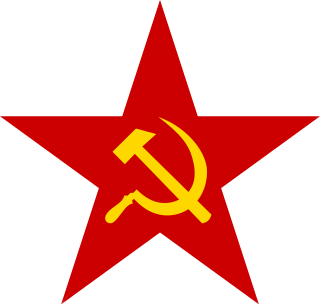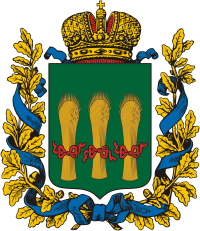
The 4th Guards Airborne Division was an airborne division of the Red Army that fought as infantry during World War II.
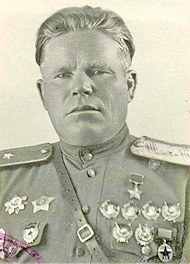
Ivan Nikitich Konev was a Soviet major general during World War II and a Hero of the Soviet Union. Konev led the 3rd Guards Airborne Division through most of the war and was awarded the title Hero of the Soviet Union for his leadership of the division during the Jassy–Kishinev Offensive. Postwar, Konev continued to serve in the Soviet Army and became the deputy commander of multiple army corps.
Ghali Zakirov was a Tatar Soviet soldier and Hero of the Soviet Union. Zakirov was awarded the title for his actions in the Battle of the Dnieper, where he reportedly killed over 100 German soldiers. He was killed in action a month after being awarded the title in January 1944.
Oleg Ioilevich Kokushkin was a Red Army lieutenant colonel and posthumous Hero of the Soviet Union. Kokushkin joined the Red Army in 1931 and became a political commissar. Kokushkin fought in the Battle of Kiev (1941), the Battle of Moscow, and the Battle of Stalingrad. In November 1942 he was sent to the "Vystrel" courses and after completing the course became commander of the 3rd Guards Airborne Division's 8th Guards Airborne Regiment. Kokushkin led the regiment in the Battle of Kursk, Operation Kutuzov and the Chernigov-Pripyat Offensive. He was killed in action when a German bomb struck his command post. Kokushkin was posthumously awarded the title Hero of the Soviet Union for his leadership of the regiment.

Alexander Andreyevich Kolesov was a Soviet officer and Hero of the Soviet Union. Kolesov was awarded the title for his actions during the Battle of the Dnieper. Due the wounds he suffered during the fighting, Kolesov was not able to hold another combat post during the war. However, he returned to the Army postwar and eventually retired as a colonel. He later worked as a quality controller within the Soviet military equipment procurement organization.
Pyotr Ivanovich Kuznetsov was a Red Army junior sergeant during World War II and a Hero of the Soviet Union. Kuznetsov was awarded the title for his actions in the 1943 Battle of Kiev, where he reportedly killed 41 German soldiers. He was seriously wounded and discharged soon after. After the war, Kuznetsov lived in Kaluga.
Georgy Andrianovich Morozov was a Red Army sergeant and a Hero of the Soviet Union. Morozov was awarded the title for reportedly killing 50 German soldiers during the Battle of the Dnieper and capturing a machine gun. Postwar, he was an overseer at an engineering plant in his home of Elektrostal.
Nikolai Ilyich Usenko was a Red Army man and Hero of the Soviet Union. Usenko was awarded the title on 10 January 1944 for his actions during the Battle of the Dnieper in October 1943. During the battle, Usenko, a telephonist, was reported to have repaired numerous breaks in the line, often under German fire. He was also reported to have killed 25 German soldiers. Later he was seriously wounded and blinded by a German shell and medically retired from the Red Army. He subsequently returned to his home in Krasnoyarsk Krai and worked in the logging industry.
Yevgeny Mikhailovich Obukhov was a Red Army sergeant and Hero of the Soviet Union. Obukhov was awarded the title Hero of the Soviet Union and the Order of Lenin for his actions during the Battle of the Dnieper. He was killed in action a short time later.
Arkady Yegorovich Chepelev was a Red Army Starshina or sergeant major and Hero of the Soviet Union. He was awarded the title for ferrying weapons and ammunition to troops in the Dnieper bridgehead and repelling counterattacks during the Battle of the Dnieper. Chepelev continued to fight in combat and served with the 167th Rifle Division during the Lvov–Sandomierz Offensive and Battle of the Dukla Pass, among others. He was demobilized postwar and returned to Voronezh, working as a mechanic in an aircraft factory.
Ilya Timofeyevich Osipov was a Tatar Red Army soldier and posthumous Hero of the Soviet Union. Osipov was awarded the title for his work with pontoon bridges during the Battle of the Dnieper, but went missing in January 1944.

Dmitry Ivanovich Rodin was a Red Army junior lieutenant and Hero of the Soviet Union. Rodin was awarded the title for his leadership of a platoon during the Lublin–Brest Offensive, during which he was seriously wounded for the sixth time. As a result of this, Rodin spent the rest of the war in the hospital and was discharged in April 1945. Postwar, he worked as an engineer in the Ministry of Railways design and research institute.
Grigory Samoylovich Kabakov was a Ukrainian Red Army lieutenant and Hero of the Soviet Union. Kabakov was awarded the title for leading his company during the Battle of the Dnieper in September 1943, where he reportedly killed 60 German soldiers.
Dmitry Timofeyevich Kamolikov was a Red Army sergeant and a Hero of the Soviet Union. Kamolikov was awarded the title for his actions in the Budapest Offensive during the crossing of the Tisza, when he reportedly led the repulsion of 12 counterattacks. He was seriously wounded in the battle and was discharged. Postwar he worked as an engineer at a factory equipment supply factory.

Sharifzyan Gabdurahmanovich Kazanbaev was a Tatar Red Army sergeant major or Starshina and posthumous Hero of the Soviet Union. Kazanbaev was awarded the title posthumously for his actions in the Uman–Botoșani Offensive. Kazanbaev was mortally wounded saving his regiment's colour.
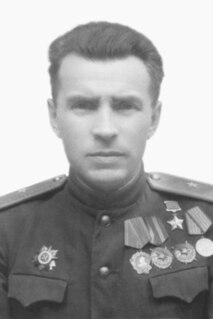
Leonid Alexandrovich Kolobov was a Soviet Army Lieutenant general and Hero of the Soviet Union. After being drafted into the Red Army in 1928, Kolobov graduated from the Moscow Infantry School and became an officer. In 1940 he became chief of staff of a Finnish People's Army infantry division. In September 1941, Kolobov became chief of staff of the 408th Rifle Division in Iran. From September 1942 he commanded the 389th Rifle Division. He led the division until the end of the war, being awarded the title Hero of the Soviet Union for his leadership in the Lvov–Sandomierz Offensive. Postwar, he led the 97th Guards Rifle Division, 114th Guards Airborne Division, 86th Guards Rifle Division and 4th Guards Army Corps. Kolobov also served as an adviser in East Germany during the 1950s. He retired in 1969, lived in Moscow and died in 1993.
Nikolai Panteleyevich Kabak was a Red Army sergeant and Hero of the Soviet Union. He was awarded the title for reportedly ferrying troops and equipment during the Battle of the Dnieper in October 1943. Postwar, Kabak was chairman of the local village council and worked for a brick factory and a shipping company.

Ivan Andreyevich Kabalin was a Soviet Army junior lieutenant and Hero of the Soviet Union. Kabalin was a sergeant and a squad leader in a mortar company during the Battle of the Dnieper and was awarded the title Hero of the Soviet Union for reportedly killing 250 German soldiers while repulsing counterattacks. Kabalin stayed in the army postwar and retired in 1955 as a junior lieutenant. He worked as a turner and then director of a carriage works after graduating from a railway college.
Vasily Grigoryevich Kabanov was a Red Army major and Hero of the Soviet Union. Drafted into the Red Army in 1930, Kabanov fought in the Battle of Lake Khasan and the Battles of Khalkhin Gol as a tank company Politruk. After being seriously wounded in fighting around Leningrad, he took refresher courses at the Red Army Military Academy of Mechanization and Motorization. Kabanov returned to the front in January 1945 as a tank battalion commander and fought in the Vistula–Oder Offensive, where his battalion helped take Skierniewice. For his leadership, Kabanov was awarded the title Hero of the Soviet Union. He was mortally wounded during the Battle of Berlin.
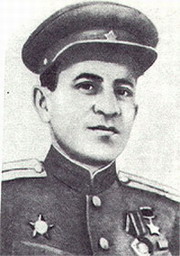
Mammad Ali oglu Maharramov was an Azerbaijani Red Army lieutenant and a Hero of the Soviet Union. Maharramov fought in the Winter War after being drafted into the Red Army in 1941. He fought in World War II from 1941 and was awarded the title Hero of the Soviet Union on 22 February 1944 for leading his squad in reportedly killing 50 German soldiers during the Battle of the Dnieper, among other actions. After the war, Maharramov was chairman of the village council and a kolkhoz.
